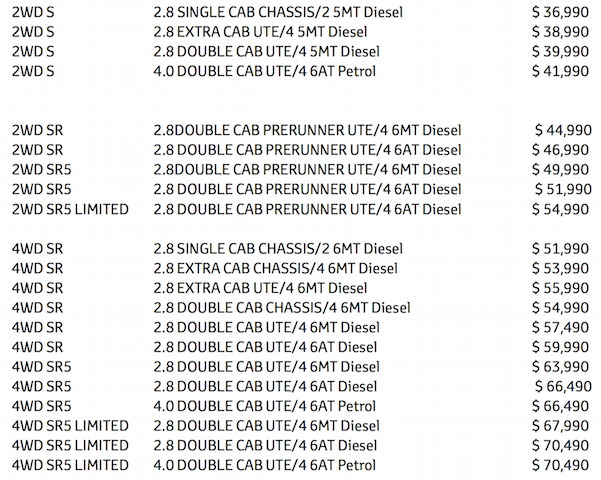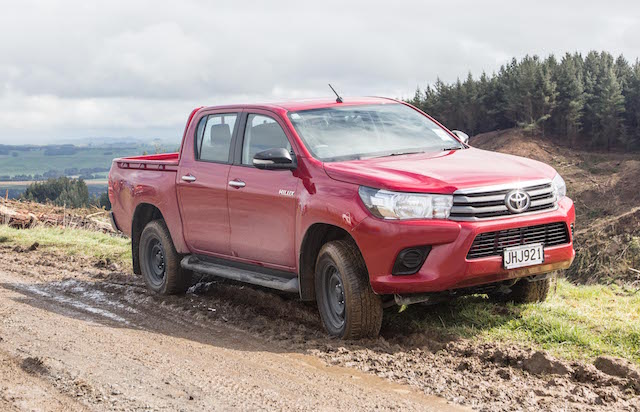
Toyota has borrowed a name from its American line-up of light trucks to help it compete in a segment of the New Zealand market that has been exclusively Ford’s for the past few years.
Enter the new Hilux PreRunner (above), a higher-riding 2WD ute that looks like a 4WD, in the same way as the Hi-Rider 2WD Ford Ranger looks like the 4WD Ranger.
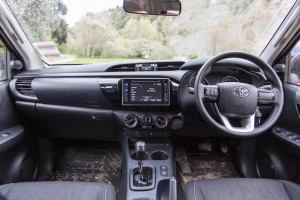
Ford’s sleight of hand with the Hi-Rider 2WD Ranger and its six-speed automatic gearbox has more than anything helped Ranger tip Hilux off the top of the sales ladder in the past two years. Hilux has sold more 4WDs than Ranger, a powerful reminder that says much about the Hilux and strength of the Toyota brand.
But Toyota never had a higher-riding 2WD competitor when it needed it. Its 2WD offerings were further hamstrung by five-speed manual-only models, whereas Ford offered six-speed automatics. This while the light truck segment grew from 13,600 sales in 2011 to a projected 28,000 this year.
“Here’s the most telling trend,” says Steve Prangnell, Toyota NZ general manager of sales. “Since 2011, more than 30 per cent of the light truck market has shifted from manual to automatic, a combination of increasing traffic congestion, improving transmissions and just pure convenience, and as the motoring public’s preference shifted we couldn’t move with the market.”
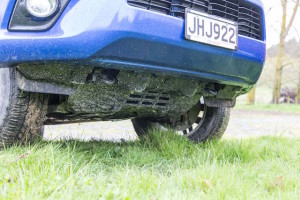
Now it can, thanks to a wider range of six-speed automatic gearboxes and models like the PreRunner. The name has been used since 1998 on variants of the Toyota Tacoma, a made-in-America light truck bigger than Hilux. It’s a rear-driver with a lift kit, a lookalike 4WD for those Yankee Doodle Dandies who like the better visibility of a high-rider but don’t need all four paws doing the work.
But while the Tacoma PreRunner gets an electronic locking rear differential, Hilux PreRunnner doesn’t, a fact that Prangnell and Spencer Morris, the general manager of product for Toyota NZ, only became aware of at the NZ press launch of the new Hilux.
Oops! Because the higher-riding 2WD Ranger, the model the Hilux PreRunner specifically targets, has a locking rear diff, an advantage when extra traction is needed.
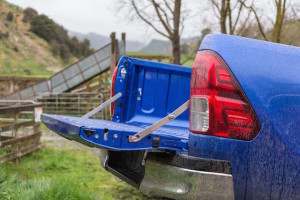
Prangnell doesn’t see its absence on the Hilux as a disadvantage. “The key thing for us is that we now have a two-wheel-drive high-rider with auto (gearbox). We haven’t been in that segment at all.”
Told that Ford was likely to jump on the fact that Ranger had a rear locker but PreRunner didn’t, Prangnell said: “If that’s all Ford want to jump on us for, I’m happy with that.”
The Ranger/Hilux battle for supremacy resumes in earnest now that Toyota has an all-new model to face off against the updated Ranger. A two-day press launch on- and-off road from Palmerston North through to the Tararua District and up to Napier showed that Hilux is ready for the fight.
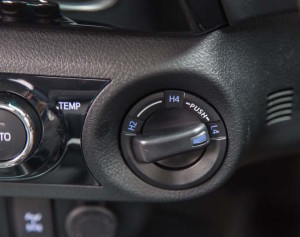
It mightn’t have the Ranger’s cushier ride but it looks good inside and out and steers and handles well. Its new 2.8-litre diesel matched with either a six-speed automatic or six-speed manual is a classy powertrain, quiet and arguably at its best in the manual 2WD PreRunner with the SR5 badge and iMT button, a so-called intelligent feature that smooths out progress when changing down, a modern version of the old double-declutch method.
There are 21 Hilux variants – nine 2WD, 12 4WD – nine more than in the outgoing line-up. The 4WDs all get a locking rear diff. The range gets a stronger chassis, stiffer body, and strengthened suspension and brakes for greater off-road ability. There is also a 4.0-litre petrol V6 in the mix.
There are four different grades, each one earning a five-star crash rating: The S models are 2WD only; the SR badges are on both the higher-riding 2WD and 4WD variants; and the better equipped SR5 and SR5 Limited are top drawer.
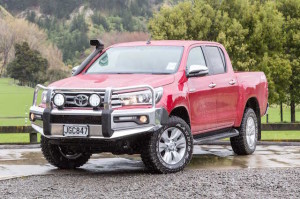
“The light truck segment now meets the wider needs of customers who may have previously been sedan or station-wagon drivers” said Prangnell. “That’s a key reason for our expanded model range, especially the greater number of automatic transmission choices.
“Every year we are seeing the continued urbanisation of the truck market. It’s leading to the demise of family sedans and wagons. Trucks appeal to the Kiwi lifestyle more than ever before.”
This is borne out by the growth over the past 10 years of accessories for vehicles like Hilux. In 2005 Toyota was doing around $6 million in add-ons. The seventh-generation Hilux pushed annual business in accessories to $12m by 2007. These days Toyota is turning over around $23m – $19m of it through the dealer network and $4m through corporate and fleet sales.
Some things about the new Hilux:
- SR5 gains six-spoke alloy wheels, auto levelling LED headlights, fog lamps, keyless smart entry and start, climate control air conditioning and satellite navigation. The SR5 Limited adds leather upholstery, 12-spoke alloy wheels, fog lamp garnish and a power driver’s seat.
- Five-star ANCAP safety rating comes with seven airbags, vehicle stability and traction control, anti-lock brakes with brake assist, electronic brakeforce distribution and trailer sway control. There are reversing cameras on all models fitted with a wellside,
- New 2.8-litre diesel engine delivers up to 450Nm between 1600 and 2400rpm – a 25 per cent increase on the previous 3.0-litre engine. It can deliver up to 80 percent of its maximum torque from as low as 1200rpm.
- New leaf springs are longer and mounted wider apart for better towing and load carrying ability, while wheel articulation has been improved by up to 20 per cent for greater off-road capability through the adoption of a rear differential lock on 4WD models. Ground clearance has increased up to 286mm, depending on the model, and hill start assist is standard across all variants to enable safer and easier starts on an incline.
- A stronger and wider underbody protection now covers 30 per cent more in area and has a 40 per cent increase in thickness, designed to protect essential parts, deflect harmful objects and offer easier access for cleaning.
- In the cabin there is driver seat height adjustment and a telescopic and height adjustable steering column for all models except the 2WD single cab variant, while rear seat occupants in double cab models gain more knee room and two ISOFIX child restraint anchors.
- On the steering wheel there are multi-media and phone controls with Bluetooth capability for added convenience.
- Wheel sizes vary between 16” and 17” for S and SR grades, and SR5 grades gain 17” alloy wheels and 18” alloy wheel designs come standard on SR5 Limited models.
- Braked towing capacity ranges from 3.5 tonnes for the 4WD manual SR5 to 2.5 tonnes for the 2WD.

